
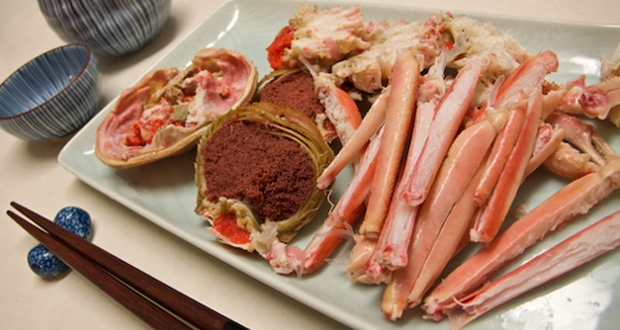
Male snow crabs caught in Ishikawa prefecture are named "Kanou-gani." Conversely, we have called the female crabs "kobako (flavor box)" since olden times.
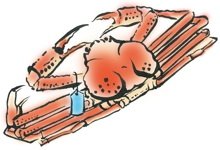
Winter (Nov6 - Mar 20)
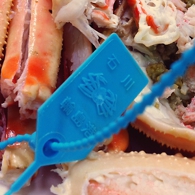
The season starts on the 6th of November. Therefore, on the 7th is the first sale of the season. Local people go to a super market or open-air market such as Ohmicho Ichiba, to get the first catch. Just so you know, the blue tag guarantees you that you are buying Kanou-gani, and it also indicates the fishing port where it's from, such as Kanazawa-kou, Hashitate-gyokou, or Wajima, amongst others.
価格 the prices
800 - 20,000 yen
Prices depend on the size and weight. Zuwai-gani is well-known as a high-grade crab, because of its excellent taste. They live at a depth of around 200 - 400 meters, and the water temperature is about 1-3 degrees Centigrade. As a result, the crab meat is thick and tasty. Usually it takes 10 years for a male crab to reach an excess of one kilogram in weight, and for the width of the abdomen to be 12-15 cm, with the full length of the crab between 70-80 cm. The price of a female crab is more affordable of course, simply due to their smaller size.
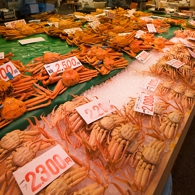
食べ方 how to eat
With Sanbaizu Sauce
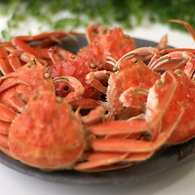
So, how do you think we usually eat crab in Japan? Vibrant snow crab meat dipped in sanbaizu sauce (a mixture of vinegar, soy, and sugar) is the most common method! And although many might find it disgusting, the Japanese consider that crab brain to be the best part! Besides, kobako has beautiful roe as well. Open the shell and drizzle some sauce over it! As a matter of fact, while the super expensive male crabs are immediately sent to big cities such as Tokyo, their female counterparts are more popular for local people!
By SHIZUO
Published: December 8, 2012
Kanazawa Area
Kenroku-En Garden
Seisonkaku Villa
Kanazawa-Jo Castle
Hishi-Yagura/<br>Gojikken-Nagaya/<br>Hashizume-Mon Tsuzuki-Yagura Museum
Chaya-Gai<br>Geisha Districts
Nagamachi Buke-Yashiki-Ato (Previous Samurai District)
21st Century Museum of<br> Contemporary Art, <br>Kanazawa
Nomura-Ke<br>Samurai House
Yuwaku Onsen-Kyo Spa Village
Kanazawa Yuwaku Edo-Mura Museum
Following Matsuo Bashô’s steps in Ishikawa - 1/6 [Introduction]
Following Matsuo Bashô’s steps in Ishikawa - 2/6 [Kanazawa]
Light-Up Bus
Noto Area
Rokkosaki Cape
Mitsukejima Island
Day Trip from Kanazawa #01-Wakura-Onsen Spa Town Nanao City
Day Trip from Kanazawa #01-Ipponsugi Dohri Street Nanao City
Noto-Jima Glass Art Museum
Wajima Asaichi Morning Market
Sohjiji Soin Temple
Kaga Area
Komatsu Experience
Shirayama Hime-Jinja Shrine
Daishoji District
Kaga-Hashidate District
Higashitani Mountainous Area
Following Matsuo Bashô’s steps in Ishikawa - 3/6 [Komatsu City]
Following Matsuo Bashô’s steps in Ishikawa - 4/6 [Natadera Temple]
Following Matsuo Bashô’s steps in Ishikawa - 5/6 [Yamanaka Onsen Town]
Following Matsuo Bashô’s steps in Ishikawa - 6/6 [Daishoji District]
Rosanjin in Yamashiro Onsen Town
Hakusanroku Gibier: Local cuisine utilized wild game from the mountain area
Noto no Shio: Salt extracted from the sea
Jizake: Local sake in Hokuriku region
Buri: Yellowtail
Kaga-ryori:<br>The Traditional Local Food
Kanou-gani & Kobako snow crabs
Kaga Yasai:<br>Traditional Vegetables
Tempura
Sushi
Komatsu Udon Noodle
Event
Enyukai: Geisha Party
Geisha Performance with Dinner
Sunday Zazen Session
Custom
Shintoism
Arts and Crafts
Yamanaka Shikki: <br>Lacquer Ware made in Yamanaka
Wajima Nuri<br>Lacquerware
Wagasa<br>(Traditional Umbrella)
Kaga Temari<br>(Traditional Handball)
Kaga-Yubinuki<br>(Traditional Thimble)
Kutani-Yaki<br>Porcelain
Aochibu Blue Dot(br)Kutani Artist - Kingyoku Nakata
Kaga Hachiman Okiagari<br> Paper Doll
Kaga Kebari<br>Feather Bait
Stroll Kanazawa in Rental Kimono - 1/2 [Renting kimono]
Stroll Kanazawa in Rental Kimono - 2/2 [Strolling in Kimono]
January
Dezomeshiki<br>Firefighters' Ceremony
Enyukai: Geisha Party
February
Setsubun-Sai Festival
Yukidaruma Matsuri<br>
Festival
April
Enyukai: Geisha Party
Sakura Viewing
May
Seihakusai Festival
Kutani Chawan Matsuri
(Outdoor Market)
Otabi Matsuri Festival
Okaeri Matsuri Festival
June
Hyakumangoku Matsuri<br>Festival
July
Enyukai: Geisha Party
Abarei Matsuri Festival
Yamashiro Daidengaku Dance Festival
August
Issaki Hoh-toh Matsuri Festival
Niwaka Matsuri Festival
November
Kanou-gani & Kobako snow crabs
Enyukai: Geisha Party
December
Enyukai: Geisha Party
All Year Round
Wajima Asaichi Morning Market
Sunday Zazen Session
Light-Up Bus
Shops
Stroll Kanazawa in Rental Kimono - 1/2 [Renting kimono]
Stroll Kanazawa in Rental Kimono - 2/2 [Strolling in Kimono]
Sunday Zazen-Session
Paragliding
Snowboarding
Pottery-Making
Kanazawa Smoking<br>Etiquette Guide
Special Interview<br>after the Tohoku Earthquake
Tourist Centers
About Ishikawa Prefecture
How to Get to Kanazawa
Access from Tokyo
Access from Osaka
Access from Nagoya
Access from Takayama
How to Get to the Noto Peninsula
About Us


